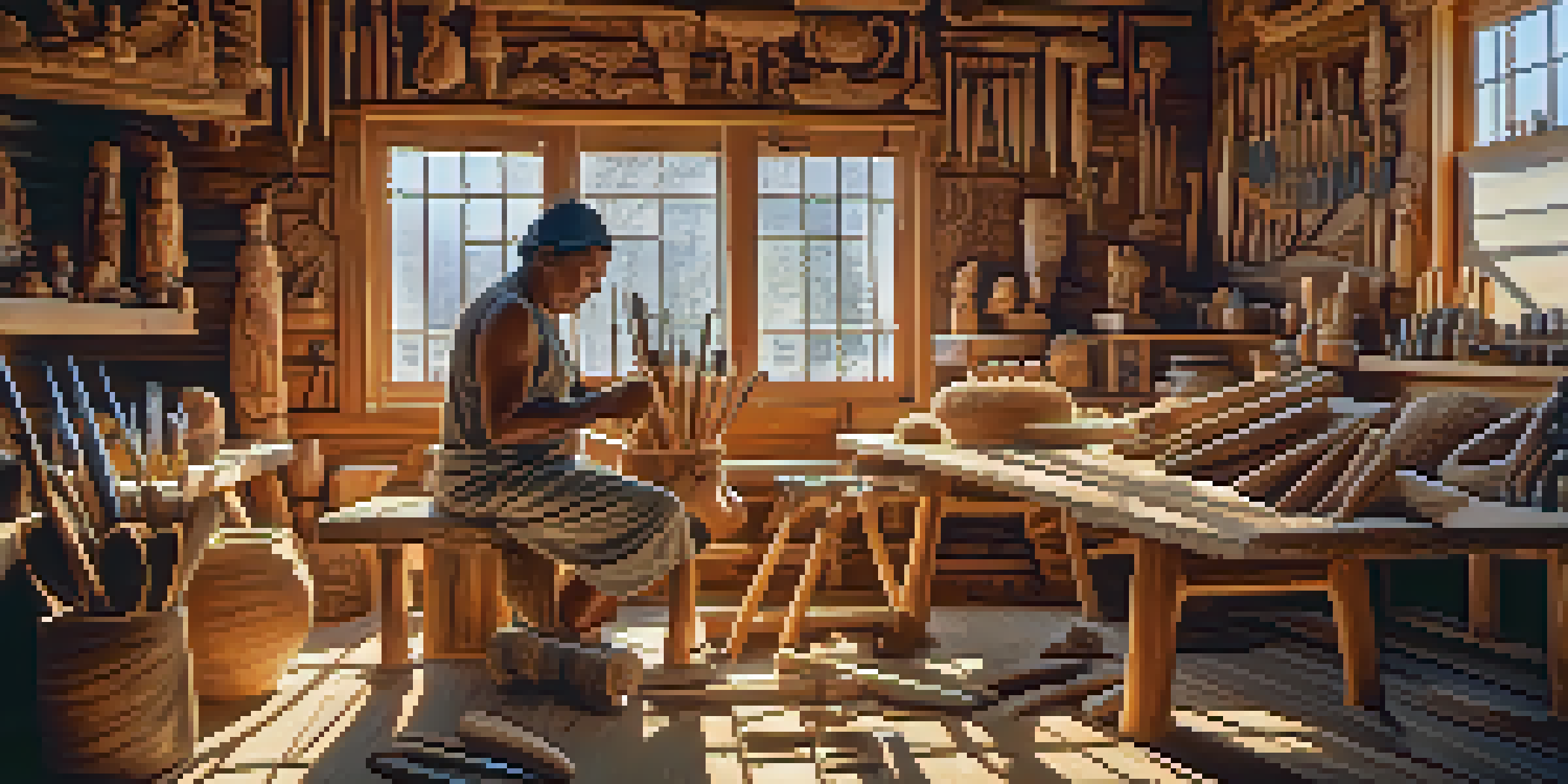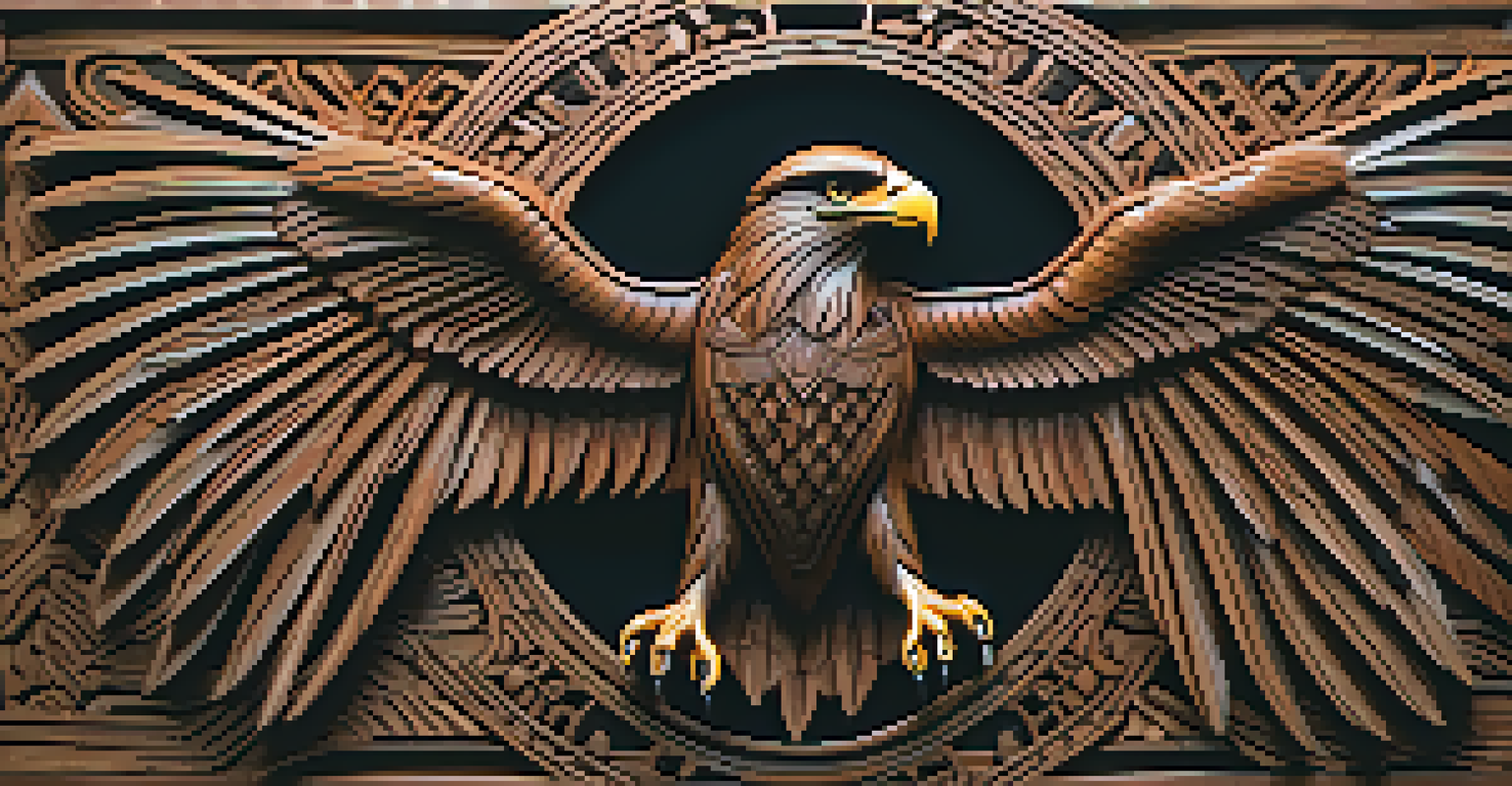Exploring Indigenous Carving Techniques in Cultural Narratives

Understanding Indigenous Carving: A Cultural Foundation
Indigenous carving is not just an art form; it is a profound expression of cultural heritage. Each piece tells a story, often linked to the identity and beliefs of the community. Carvers draw inspiration from nature, mythology, and ancestral teachings, weaving these elements into their work.
Art is a reflection of society, and it has the power to communicate cultural narratives that resonate across generations.
For many Indigenous cultures, carving serves as a way to connect with the past and honor the spirit of their ancestors. This practice goes beyond aesthetics; it is a vital means of preserving history and passing down knowledge through generations. Think of it as a living archive, where each carving is a chapter in a larger narrative.
Moreover, the materials used in carving—whether wood, stone, or bone—are often sourced from the local environment, further emphasizing the relationship between the carver and their land. This connection not only enriches the artwork but also reinforces the community's respect for nature.
Carving Techniques: Tools of the Trade
Indigenous carvers utilize a variety of tools and techniques, each tailored to the specific material they work with. Traditional tools often include chisels, knives, and even handmade implements that reflect the ingenuity of their craftsmanship. For instance, a finely honed stone tool may be used to create intricate details in wood, showcasing the carver's skill.

The techniques can vary significantly between different Indigenous groups, with each community developing its own unique styles. Some may focus on relief carving, where designs are raised from the background, while others might prefer in-the-round carving, creating three-dimensional figures. This diversity adds layers of richness to Indigenous art, making it a fascinating field of study.
Carving as Cultural Heritage
Indigenous carving serves as a profound expression of cultural identity, preserving history and ancestral teachings through intricate artworks.
As technology advances, some carvers are incorporating modern tools, yet many still honor traditional methods. This blend of old and new creates a dynamic landscape in Indigenous carving, allowing artists to push boundaries while staying rooted in their cultural practices.
Cultural Narratives Embedded in Carvings
Every carving tells a story—whether it's a representation of a creation myth, a historical event, or an emblem of community identity. These narratives are intricately woven into the fabric of the artwork, inviting viewers to engage with the culture on a deeper level. For example, a carving depicting an eagle might symbolize strength and freedom, resonating with the community's values.
Tradition is not the worship of ashes, but the preservation of fire.
These stories not only enrich the artwork but also serve as educational tools, allowing younger generations to learn about their heritage. Through storytelling, carvers ensure that the lessons of the past remain alive and accessible. Imagine walking through an exhibition, where each piece calls out, urging you to listen to its tale.
Moreover, these carvings often play a role in ceremonial practices, bridging the gap between the spiritual and physical worlds. By participating in these rituals, community members can connect with their ancestors and reinforce their cultural identity, showcasing how art can be both personal and communal.
The Role of Community in Carving Practices
Community is at the heart of Indigenous carving practices, fostering collaboration and sharing of knowledge. Many carvers work alongside mentors, passing down techniques and stories that have been honed over centuries. This collaborative approach not only strengthens individual skills but also reinforces community bonds.
Workshops and carving events often bring people together, allowing for the exchange of ideas and techniques. Imagine a gathering where laughter fills the air as participants carve side by side, each contributing to a collective masterpiece. This sense of shared purpose enhances the cultural experience and creates lasting memories.
Community's Role in Carving
The collaborative nature of carving within Indigenous communities strengthens bonds and ensures the transmission of techniques and stories across generations.
Additionally, community support plays a crucial role in preserving these traditions. By valuing and promoting Indigenous art, communities ensure the survival of their cultural narratives, allowing future generations to take pride in their heritage. Through this lens, carving becomes a communal endeavor, echoing the values of unity and resilience.
Contemporary Influences on Indigenous Carving
In recent years, contemporary influences have begun to shape Indigenous carving, as artists explore new themes and mediums. This evolution reflects the dynamic nature of culture, where tradition meets innovation. Carvers today may incorporate modern motifs, address current social issues, or experiment with mixed media, broadening the scope of their work.
While some purists may resist these changes, many see them as a natural progression of their art. This blending of styles can create powerful statements that resonate with a wider audience, drawing attention to important cultural narratives. Consider how a traditional carving might juxtapose with contemporary elements, sparking conversations about identity and belonging.
Furthermore, contemporary Indigenous carvers often utilize social media and online platforms to showcase their work, reaching audiences far beyond their local communities. This global exposure not only elevates their art but also raises awareness about the significance of their cultural narratives in today's world.
Preservation Efforts for Indigenous Carving Traditions
As Indigenous carving techniques face the challenges of modernization and globalization, various preservation efforts are underway. Organizations and community leaders are actively working to document these practices, creating archives that capture the rich history and artistry of carving. These initiatives are crucial for ensuring that traditional skills are not lost to time.
Educational programs play a significant role in these preservation efforts, teaching younger generations about the importance of their cultural heritage. Through workshops, classes, and mentorships, communities are passing down skills and stories that define their identity. Picture a young carver, guided by an elder, learning not just how to carve, but also the stories behind each cut.
Contemporary Influences on Art
Modern themes and digital platforms are reshaping Indigenous carving, allowing artists to blend tradition with innovation and reach global audiences.
Additionally, collaborations with museums and art institutions help to promote Indigenous art on a larger scale, providing a platform for carvers to share their work and narratives. These partnerships not only foster appreciation for the art form but also challenge misconceptions about Indigenous cultures, highlighting their vibrancy and relevance in today's society.
The Future of Indigenous Carving and Cultural Narratives
Looking ahead, the future of Indigenous carving holds exciting possibilities as artists continue to innovate while honoring their traditions. The younger generation is increasingly embracing their heritage, often blending it with contemporary elements to create unique expressions. This fusion can breathe new life into age-old techniques, making them relevant for modern audiences.
Moreover, with the rise of digital platforms, Indigenous carvers have unprecedented opportunities to reach global audiences. This exposure can foster greater understanding and appreciation for their cultural narratives, transforming art into a medium for dialogue. Imagine a worldwide community engaging with these stories, each interaction adding depth to the collective understanding of Indigenous cultures.

Ultimately, the ongoing evolution of Indigenous carving is a testament to its resilience and adaptability. As artists continue to carve their paths, they not only preserve their cultural heritage but also ensure it thrives in a diverse and interconnected world.